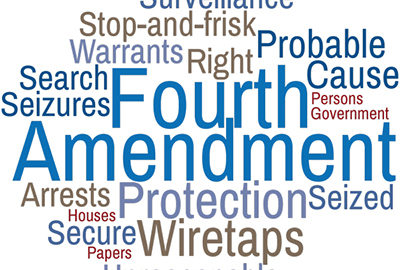Terry v. Ohio
88 S.Ct. 1868
U.S. Supreme Court
Decided June 10, 1968
More information on Federal Appeals and Petitions to the United States Supreme Court
Fourth Amendment Search and Seizure: The Origin of the “Terry Stop” – Temporary Stops and Searches
This week’s Throw-Back-Thursday blog is the case that established the infamous Terry Stop where police were authorized to stop and frisk a suspect when the police believe that there is reasonable suspicion that the person is committing, has committed or is about to commit a crime and the person may be armed. This case eventually would lead to the recent controversy of “stop and frisk” in many State jurisdictions.
Issue: Whether a police officer’s “stop and frisk” of an individual violates of the Fourth Amendment of the United States Constitution.
Holding: The Supreme Court held that when an officer acts “reasonably” in performing a search and seizure, even without probable cause, the search and seizure is not a violation of the Fourth Amendment when the if the police officer has a reasonable suspicion that the person has committed, is committing, or is about to commit a crime and has a reasonable belief that the person “may be armed and presently dangerous.
The Stop and Frisk and Arrests of Terry and Chilton
A detective patrolling downtown Cleveland spotted two men, John Terry and Richard Chilton, on a street corner and suspected that something was amiss based on the behavior of the men. The detective observed Terry and Chilton repeatedly walking back in forth on the same street, pausing to look into the same store window each time they passed by. Suspecting that the men were about to perform a “stick up,” the detective approached Terry and Chilton along with a third man who had met them named Katz, identified himself as an officer, and proceeded to pat down Terry. The detective felt a revolver on Terry’s person and, after leading the three men inside the store, he ordered Terry to remove his coat so he could retrieve the weapon. The officer went on to perform a complete pat down of Terry, Chilton, and Katz. Another revolver was discovered on Chilton’s person and Terry and Chilton were subsequently charged with carrying concealed weapons.
Fourth Amendment Issue at Trial
The defense counsel of Terry and Chilton moved to suppress the weapons as evidence, arguing that the seizure violated the Fourth Amendment. The court denied the motion and admitted the revolvers into evidence on the grounds that the detective had reason to believe that Terry and Chilton were acting suspiciously and that because the officer had reason to believe the men might be armed, he was allowed to frisk them for his own safety. After the trial court denied the motion to suppress, Terry and Chilton pled guilty.
When is a Search or Seizure “Reasonable”?
Under the U.S. Constitution, the Fourth Amendment provides that citizens have the right against unreasonable searches and seizures by police. While the Court conceded that petitioner Terry was generally entitled to protection under the Fourth Amendment as he walked the streets, the Court questioned whether, under the circumstances as described by the arresting officer, the search and seizure was unreasonable. How, then, the Court questioned, do we know when a search or seizure is reasonable and when a search or seizure violates an individual’s Fourth Amendment rights?
When an intrusion occurs without a warrant, courts look to the testimony of the arresting officer to see whether the actions taken were justified and whether the officer’s specific, articulated accounts “taken together with rational inferences from those facts, reasonably warrant the intrusion.” The Court urged lower courts to ask these questions and to require evidence of reasonableness that is based on more than just a “hunch”— evidence that the officer acted in “good faith” would not be enough. The Court held that if mere “good faith” requirement were all that was necessary to determine that the search and seizure was legal, “the protections of the Fourth Amendment would evaporate.”
Was Terry’s “Stop and Frisk” Reasonable under the Fourth Amendment?
After establishing that courts must assess the context and facts of a warrantless search or seizure, the Supreme Court was called to determine whether Terry’s “stop and frisk” was unreasonable and in violation of his Fourth Amendment rights. The Court didn’t doubt that Terry was “seized” and subjected to a “search” when the detective patted him down for weapons on the outside of his clothing. However, the question remained: did the circumstances preceding the detective’s “stop and frisk” render his decision to perform the search and seizure reasonable according to the Court’s principles?
Following its own guidelines, the Court analyzed the facts of Terry’s case and concluded that the detective’s warrantless search and seizure was reasonable. The Court rationalized that because the detective’s observations of Terry and his two companions (pacing up and down the street, continuously stopping in front of the store, etc.) led him to believe Terry and his crew were about to execute a stick-up, the detective acted reasonably. Also noting that the detective initially limited his search to a pat down of the outside clothing, the Court concluded that his decision was a reasonable in order to protect himself and others from possible danger. Subsequently, the Court held that the weapon was properly admitted into evidence.
The Controversy that Followed
Since the decision of Terry v. Ohio, controversy over the constitutionality of “stop and frisk” searches has remained prevalent throughout the United States. In 2013, the United States District Court for the Southern District of New York axed the “stop and frisk” policy. That Court held that the “stop and frisk” rule violated the Fourth Amendment, noting that officers too often take advantage of the policy by unfairly target minorities.

